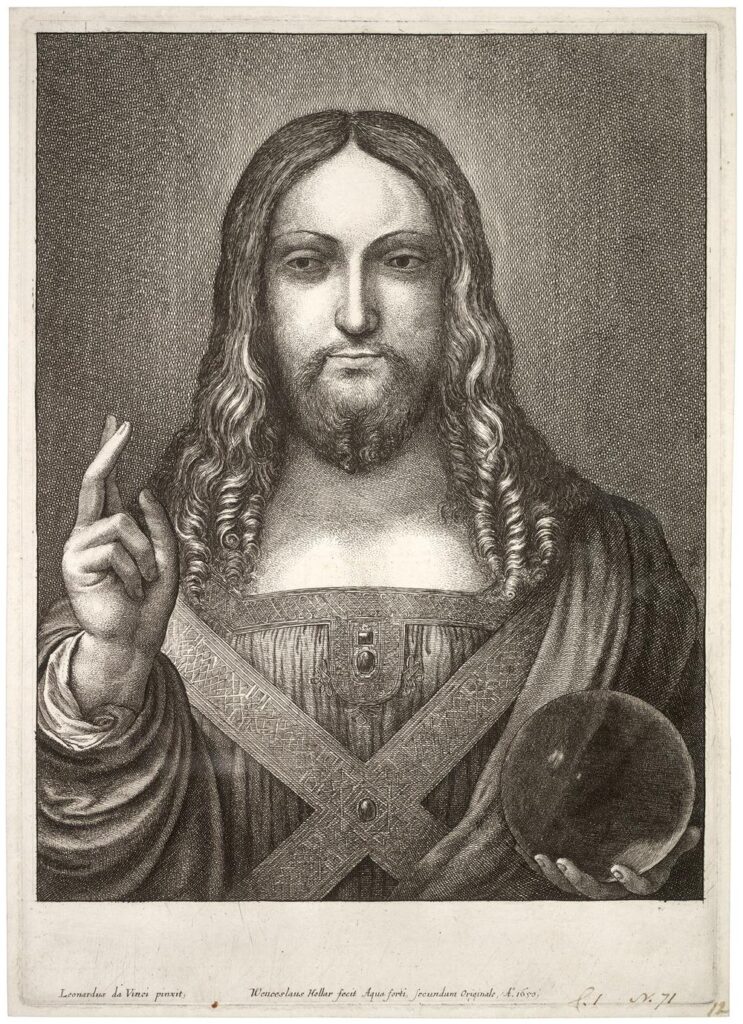Salvator Mundis’ Evolving Timeline
As Long As Something Is Uncertain or Unknown, The Concept of it Always Changes
“Time stays long enough for anyone who will use it” – Leonardo da Vinci
The Most Valuable Painting in the World has an extensive history filled with royalty, fame, mystery, intrigue, scandal, encryption, and controversy. Of course, this is all to get your attention. However, this was not orchestrated by any one person or group of people, but by Providence itself.
Below you will find a compilation of various timelines put together through extensive research. Recognizing the contributions of many along the way. It is in no way completed yet as we refuse to complete without exhaustive research, so this history content will change. Please check back often for updates.
1478-83
Leonardo may have seen Bartolomeo della Gatta’s Salvator Mundi in Urbino, or a copy, which appears to be the prototype for his Salvator Mundi design.
1496-98
Leonardo supposedly paints a Christ the Redeemer lunette (much like a Salvator Mundi format) for the Santa Maria delle Grazie tribune in Milan, part of a project that began in 1492. It was destroyed during renovations around 1603. Source: The Art Newspaper
~1506
Da Vinci began work on the painting following a commission by King Louis XII of France. (1462-1515) and his wife, Anne of Brittany (1477-1514), following the conquest of Milan and Genoa. He completed the work seven years later. Source: The Art Newspaper
Around 1508
Two red chalk drawings are produced by Leonardo in preparation for a Salvator Mundi. (They are now in the Royal Collection). Source: The Art Newspaper
1508-1520s
Associates of Leonardo’s studio, including Giovanni Antonio Boltraffio, Bernardino Luini, Francesco Melzi, and Gian Giacomo Caprotti, paint Salvator Mundi compositions based on Leonardo’s initial sketches.
1625
Potentially brought to England by Princess Henrietta Maria when she married King Charles I in 1625.
1638-41
A “Christ with a globe in his hand done by Leonardus Vinsett” is recorded in the London home of James III Marquess (later 1st Duke) of Hamilton. This could have been one of 20-27 Salvator Mundi copies.
1650
The celebrated Czech etcher Václav Hollar known as Wenceslaus Hollar in England, was one of the most prolific artists of his time, known for his drawings and etchings and reproduced decorative works by other artists. Wenceslaus Hollar, then living in exile in Antwerp, makes an etching of a Salvator Mundi which is inscribed and dated “Leonardus da Vinci pinxit” (in Latin): “Leonardo da Vinci painted it”. Hollar etched it “from the original” in 1650.
1651
“A Peece of Christ” by Leonardo, from King Charles I’s and his wife Queen Henrietta’s collection is recorded in the Commonwealth sale of 1651, when Captain John Stone purchased it. (Inventory records that the painting was sold at the Commonwealth Sale on 23, October 1651, as part of the Sixth Dividend to Captain John Stone, a mason, representing a group of creditors who received it along with other paintings as repayment of debts.) Source: Christies.com
1660
Nine years later, when Charles II (1660-1685) of England was restored to the throne and his late father’s possessions were recalled by an act of Parliament, Captain John Stone returned the painting to the royal household. It is listed in a 1666 inventory of the collection of King Charles II at Whitehall.
1685
It is speculated that the canvas (It was painted on a walnut panel and not canvas) remained at Whitehall during the reign of Charles II’s successor, his brother James II, (1633-1701) passing by descent until the late 18th century.
Source: The Image and The Hammer – By Alexndra Kindermann
Source: Britannica.com
1683-1717
From which probably removed by Catherine Sedley, Countess of Dorchester (1657-1717), or her future son-in-law, John Sheffield, 1st Duke of Buckingham and Normanby (1648-1721), Source: Christies.com
1753
and probably by descent to his illegitimate son Sir Charles Herbert Sheffield, 1st Bt. (c. 1706-1774); John Prestage, London, 24 February 1763, lot 53, as ‘L. Da. Vinci A head of our Saviour’ (£2.10). Source: Christies.com
1763
King George III purchases Buckingham House (now Buckingham Palace) and paintings that included a “Head of Our Saviour” by “L. DA. VINCI” (lot 53). This was the third king to possibly own the Cook Salvator Mundi, according to Christie’s and others in 2017.
Source: Theartnewspaper.com
Initial timeline research ends here. Please check back for updates and continuation. Thank you!
Esoteric History
“Salvator Mundi,” is shrouded in mystery and controversy and has fascinated art enthusiasts, historians, and scholars alike for centuries. Beyond its disputed attribution and record-breaking auction sale, this enigmatic artwork harbors a depth of symbolic and esoteric meanings that merit exploration.
High Quality Replica
Our high-quality replicas are a high-res digital image of the Leonardo “Salvador Mundi” printed and mounted, as is the original. The surface is enhanced with impasto created by our artists to mimic the original brushwork of the painting with a clear acrylic gel, varnished for protection and to create a more realistic presentation.

